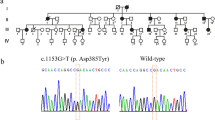Abstract
Multiple epiphyseal dysplasia (MED) is a relatively uncommon inherited disorder of epiphyseal maturation. Affected individuals may have a degree of short-limbed dwarfism, short stubby digits, and stiff or painful joints. We report two families of MED and emphasize the variations of joint involvement. Ten out of 34 members in family A and 13 out of 39 members in family B were suspected of having MED by questionnaire. Radiological examination was done for 3 out of the 10 members in family A and 6 out of the 13 members in family B. In both families, the epiphyseal disturbances in the skeleton were bilaterally symmetric and involved several joints. Apparent dwarfism, short stubby digits and spinal involvement were not observed. The degree and the pattern of affected joints were different in the two families and even among members of the same family. In family A, the knee joint was commonly affected, followed by the ankle joint. The deformity of the joints was mild and caused only slight disability. No apparent hip lesion was present. In family B, the hip joint was predominantly affected, followed by the knee and ankle joints, and the deformity was severer than that in family A. These observations suggest that MED is a group of heterogeneous disorders.
Similar content being viewed by others
Author information
Authors and Affiliations
Additional information
Received: 5 July 1999
Rights and permissions
About this article
Cite this article
Hatori, M., Watanabe, S. & Kokubun, S. Multiple epiphyseal dysplasia – report of two families. Arch Orth Traum Surg 120, 372–375 (2000). https://doi.org/10.1007/PL00013764
Issue Date:
DOI: https://doi.org/10.1007/PL00013764




